Operational Resilience of Nuclear-Renewable Integrated-Energy Microgrids
Abstract
:1. Introduction
2. Operational Resilience
- A resilience framework based on system adaptive real power of SMR-DER integrated-energy microgrids, taking into consideration the salient operational features of SMRs including flexibility added with cogeneration and the interaction between electrical and the heating system.
- A resilience metric termed as RAM is proposed for anticipated normal and compromised operational scenarios to provide resilience feedback to the microgrid’s asset management system and the reactor’s autonomous control.
3. System Description
- Reactor power maneuvering restricted in terms of total power change, ramp rates, and the total number of power maneuver cycles.
- Non-zero limits on minimum power level in addition to the maximum limits typical to all power plants.
- Fixed standard operating schedule and daily power-cycle to reduce operational uncertainty to maximize system economics and reactor safety.
- Multiple means to provide electrical power change: steam extraction, steam bypass, and reactor control rod maneuvering.
3.1. Operational Framework
3.1.1. Coarse-Loading Shaping
3.1.2. Load Following
3.1.3. Frequency Control
3.2. Asset Models
3.2.1. Small Modular Reactor
3.2.2. Heating System
3.2.3. Battery Energy Storage
3.2.4. Wind and PV Power Output Models
3.3. Resilience Framework
4. Case Study
4.1. Modified IEEE-30 Bus System
4.2. Operational Results
4.3. Resilience Evaluation
5. Conclusions and Future Work
Author Contributions
Funding
Institutional Review Board Statement
Informed Consent Statement
Data Availability Statement
Conflicts of Interest
Abbreviations
| BES | Battery energy storage |
| CLS | Coarse-load shaping |
| CO | Compromised operation |
| DER | Distributed energy resource |
| DH | District heating |
| EO | Emergency operation |
| FC | Frequency control |
| HP | High pressure |
| HX | Heat exchangers |
| IEEE | Institute of Electrical and Electronics Engineers |
| iPWR | Integral pressurized water reactor |
| LF | Load following |
| LP | Low pressure |
| MATLAB | Matrix Laboratory |
| MDS | Modern distribution system |
| NO | Normal operation |
| PSS/E | Power System Simulator for Engineering |
| PSS/SINCAL | Power System Simulator Siemens Network Calculation |
| pu | Per unit |
| PV | Photovoltaic |
| RAM | Response area metric |
| SC | Synchronous condenser |
| SG | Steam generator |
| SMR | Small modular reactor |
| SOC | State of charge |
| TES | Thermal energy storage |
| Symbols | |
| Frequency deviation threshold or the dead band for turbine bypass activation, Hz | |
| Average enthalpy of steam extracted to the heating side in the LF interval, kJ/kg | |
| Enthalpy difference of steam across the HP/LP turbine at time t, kJ/kg | |
| Maximum change limit for reactor power level in a single maneuver in NO, MWt | |
| Steam bypassed to the condenser from heating system in LF interval, kg/s | |
| Total steam extracted to the heating side in the LF interval, kg/s | |
| Instantaneous turbine bypass flow, kg/s | |
| Instantaneous steam flow through HP turbine at time t, kg/s | |
| Instantaneous steam flow through LP turbine at time t, kg/s | |
| Steam flow rate limits of heat exchangers HX1/HX2, kg/s | |
| Total steam flow output at at time t/for CLS interval, kg/s | |
| Steam extraction flow at time t/for LF interval, kg/s | |
| Solar panel efficiency | |
| Efficiency of HP/LP turbine | |
| Instantaneous wind speed at time t, km/h | |
| Cut-in, rated and cut-out speeds wind turbine, km/h | |
| Total PV panel area, m2 | |
| Instantaneous energy state of BES at time t, MWeh | |
| BES energy state initial/at time t, MWeh | |
| Upper/lower operational limits for BES SOC levels, MWeh | |
| Instantaneous solar irradiance, W/m2 | |
| Proportional and integral gain for PI controller of turbine bypass system | |
| Proportional and integral gain of the BES’s PI controller | |
| Steam flow rates to the HX1/HX2 in LF interval, kg/s | |
| Rated secondary steam flow rate of an SMR unit, kg/s | |
| Total number of reactor units in the SMR plant | |
| Number of wind turbines in the wind power plant | |
| Rated electrical power of a wind turbine, MWe | |
| Instantaneous electrical power output of BES, MWe | |
| Instantaneous electrical power output of the wind power plant at time t, MWe | |
| Instantaneous electrical power output of a PV plant, MWe | |
| Electrical power output of an SMR unit at time t, MWe | |
| Reactor thermal power level setpoint for CLS interval, MWt | |
| Maximum/minimum limits for reactor electrical power, MWe | |
| Maximum/minimum limits for reactor thermal power, MWt | |
| Maximum curtailable electrical load, MWe | |
| Heating demand for LF interval, MWt | |
| Total heat extracted to the heating side in the LF interval, MWt | |
| Heat supplied to the TES from HX2 in LF interval, MWt | |
| Heat supplied by the TES to the heating load in LF interval, MWt | |
| Maximum curtailable thermal load, MWt | |
| Ramp rate limits for the reactor maneuvering while ramping up/down, MWt/h | |
| State of charge of BES and TES at time t, pu | |
| Ambient temperature, C | |
| Temperature of the TES in LF interval, C | |
| Time period of CLS interval or reactor maneuvering cycle, h | |
| Steam extraction temperature, C | |
| Time period of LF interval, min | |
| Maximum time for continuous 100% turbine bypass, min | |
| Maximum limit on TES temperature, C | |
| Minimum limit on TES temperature, C | |
| Reactor ramping/hold period, h | |
| Predicted peak heating demand of interval | |
| Electrical demand at time t, MWe | |
| Heating demand at time t/for LF interval, MWt |
References
- Brundtland, G. Report of the World Commision on Environement and Development: Our Common Future; Oxford Paperbacks: Oxford, UK, 1987. [Google Scholar]
- Kenward, A.; Raja, U. Blackout: Extreme Weather, Climate Change and Power Outages; Technical Report; Climate Central: Princeton, NJ, USA, 2014. [Google Scholar]
- U.S. Department of Energy Office of Electricity Delivery and Energy Reliability. Economic Benefits of Increasing Electric Grid Resilience to Weather Outages; Technical Report; Executive Office of the President: Washington, DC, USA, 2013.
- Busby, J.W.; Baker, K.; Bazilian, M.D.; Gilbert, A.Q.; Grubert, E.; Rai, V.; Rhodes, J.D.; Shidore, S.; Smith, C.A.; Webber, M.E. Cascading risks: Understanding the 2021 winter blackout in Texas. Energy Res. Soc. Sci. 2021, 77, 102106. [Google Scholar] [CrossRef]
- Panteli, M.; Mancarella, P. The grid: Stronger, bigger, smarter?: Presenting a conceptual framework of power system resilience. IEEE Power Energy Mag. 2015, 13, 58–66. [Google Scholar] [CrossRef]
- McJunkin, T.R.; Reilly, J.T. Net-Zero Carbon Microgrids; Technical Report INL/ EXT-21-65125; Idaho National Laboratory: Idaho Falls, ID, USA, 2021. [Google Scholar] [CrossRef]
- International Atomic Energy Agency. Advances in Small Modular Reactor Technology Developments: A Supplement to IAEA Advanced Reactors Information System (ARIS); IAEA: Vienna, Austria, 2016; p. 400. [Google Scholar]
- Poudel, B.; McJunkin, T.R.; Kang, N.; Reilly, J.T. Small Reactors in Microgrids: Technical Studies Guidance; Technical Report INL/EXT-21-64616-Rev000; Idaho National Laboratory: Idaho Falls, ID, USA, 2021. [Google Scholar] [CrossRef]
- Kennedy, J.C.; Bragg-sitton, S.; Mcclure, P. Special Purpose Application Reactors: Systems Integration Decision Support; Technical Report INL/ EXT-18-52369; Idaho National Laboratory: Idaho Falls, ID, USA, 2018. [Google Scholar]
- Islam, M.R.; Gabbar, H.A. Study of small modular reactors in modern microgrids. Int. Trans. Electr. Energy Syst. 2015, 25, 1943–1951. [Google Scholar] [CrossRef]
- Ingersoll, D.T.; Colbert, C.; Houghton, Z.; Snuggerud, R.; Gaston, J.W.; Empey, M. Can Nuclear Power and Renewables be Friends? In Proceedings of the International Congress on Advances in Nuclear Power Plants (ICAPP), Nice, France, 3–6 May 2015; p. 9. [Google Scholar]
- Joshi, K.; Poudel, B.; Gokaraju, R.R. Investigating small modular reactor’s design limits for its flexible operation with photovoltaic generation in microcommunities. J. Nucl. Eng. Radiat. Sci. 2021, 7, 1–10. [Google Scholar] [CrossRef]
- Joshi, K.A.; Poudel, B.; Gokaraju, R. Exploring synergy among new generation technologies-small modular reactor, energy storage, and distributed generation: A strong case for remote communities. J. Nucl. Eng. Radiat. Sci. 2020, 6, 1–9. [Google Scholar] [CrossRef] [Green Version]
- Ingersoll, D.T.; Colbert, C.; Bromm, R.; Houghton, Z. NuScale Energy Supply for Oil Recovery and Refining Applications. In Proceedings of the International Congress on Advances in Nuclear Power Plants (ICAPP), Charlotte, NC, USA, 6–9 April 2014; pp. 2344–2351. [Google Scholar]
- Ingersoll, D.T.; Houghton, Z.J.; Bromm, R.; Desportes, C. NuScale small modular reactor for Co-generation of electricity and water. Desalination 2014, 340, 84–93. [Google Scholar] [CrossRef]
- Lindroos, T.J.; Pursiheimo, E.; Sahlberg, V.; Tulkki, V. A techno-economic assessment of NuScale and DHR-400 reactors in a district heating and cooling grid. Energy Sources Part B Econ. Plan. Policy 2019, 14, 13–24. [Google Scholar] [CrossRef]
- Värri, K.; Syri, S. The Possible Role of Modular Nuclear Reactors in District Heating: Case Helsinki Region. Energies 2019, 12, 2195. [Google Scholar] [CrossRef] [Green Version]
- International Atomic Energy Agency. Opportunities for Cogeneration with Nucelar Energy; Technical Report NP-T-4.1; IAEA Nuclear Energy Series: Vienna, Austria, 2013. [Google Scholar]
- Locatelli, G.; Boarin, S.; Fiordaliso, A.; Ricotti, M.E. Load following of Small Modular Reactors (SMR) by cogeneration of hydrogen: A techno-economic analysis. Energy 2018, 148, 494–505. [Google Scholar] [CrossRef]
- Poudel, B.; Gokaraju, R. Small Modular Reactor (SMR) Based Hybrid Energy System for Electricity and District Heating. IEEE Trans. Energy Convers. 2021, 36, 2794–2802. [Google Scholar] [CrossRef]
- Poudel, B.; Gokaraju, R. Optimal Operation of SMR-RES Hybrid Energy System for Electricity and District Heating. IEEE Trans. Energy Convers. 2021, 36, 3146–3155. [Google Scholar] [CrossRef]
- Panteli, M.; Trakas, D.N.; Mancarella, P.; Hatziargyriou, N.D. Power Systems Resilience Assessment: Hardening and Smart Operational Enhancement Strategies. Proc. IEEE 2017, 105, 1202–1213. [Google Scholar] [CrossRef] [Green Version]
- Holling, C.S. Resilience and stability of ecological systems. Annu. Rev. Ecol. Syst. 1973, 4, 1–23. [Google Scholar] [CrossRef] [Green Version]
- Tierney, K.; Bruneau, M. Conceptualizing and Measuring Resilience: A Key to Disaster Loss Reduction. In TR News; Transportation Research Board: Washington, DC, USA, 2007; pp. 14–18. [Google Scholar]
- Paolo, G.; Reinhorn, A.M.; Bruneau, M. Framework for analytical quantification of disaster resilience. Eng. Struct. 2010, 32, 3639–3649. [Google Scholar] [CrossRef]
- Ouyang, M.; Dueñas-osorio, L.; Min, X. A three-stage resilience analysis framework for urban infrastructure systems. Struct. Saf. 2012, 36–37, 23–31. [Google Scholar] [CrossRef]
- Ouyang, M.; Dueñas-osorio, L. Multi-dimensional hurricane resilience assessment of electric power systems. Struct. Saf. 2014, 48, 15–24. [Google Scholar] [CrossRef]
- Panteli, M.; Trakas, D.N.; Mancarella, P.; Hatziargyriou, N.D. Boosting the Power Grid Resilience to Extreme Weather Events Using Defensive Islanding. IEEE Trans. Smart Grid 2016, 7, 2913–2922. [Google Scholar] [CrossRef]
- McJunkin, T.R.; Rieger, C.G. Electricity distribution system resilient control system metrics. In Proceedings of the 2017 Resilience Week, RWS 2017, Wilmington, DE, USA, 18–22 September 2017; pp. 103–112. [Google Scholar] [CrossRef]
- Hovland, K.A.; Gentle, J.P.; Morash, S.; Placer, N. Resilience Framework for Electric Energy Delivery Systems; Technical Report INL/EXT-21-62326, Rev 1; Idaho Falls: Idaho, ID, USA, 2021. [Google Scholar]
- Bagchi, S.; Aggarwal, V.; Chaterji, S.; Douglis, F.; Gamal, A.E.; Han, J.; Henz, B.J.; Hoffmann, H.; Jana, S.; Kulkarni, M.; et al. Vision Paper: Grand Challenges in Resilience: Autonomous System Resilience through Design and Runtime Measures. IEEE Open J. Comput. Soc. 2020, 1, 155–172. [Google Scholar] [CrossRef]
- Panteli, M.; Mancarella, P. Influence of extreme weather and climate change on the resilience of power systems: Impacts and possible mitigation strategies. Electr. Power Syst. Res. 2015, 127, 259–270. [Google Scholar] [CrossRef]
- Chanda, S.; Srivastava, A.K.; Mohanpurkar, M.U.; Hovsapian, R. Quantifying Power Distribution System Resiliency Using Code-Based Metric. IEEE Trans. Ind. Appl. 2018, 54, 3676–3686. [Google Scholar] [CrossRef]
- Rieger, C.G. Resilient control systems Practical metrics basis for defining mission impact. In Proceedings of the 7th International Symposium on Resilient Control Systems, ISRCS 2014, Denver, CO, USA, 19–21 August 2014. [Google Scholar]
- Eshghi, K.; Johnson, B.K.; Rieger, C.G. Power system protection and resilient metrics. In Proceedings of the 2015 Resilience Week, RWS 2015, Philadelphia, PA, USA, 18–20 August 2015; pp. 212–219. [Google Scholar] [CrossRef]
- Phillips, T.; McJunkin, T.; Rieger, C.; Gardner, J.; Mehrpouyan, H. An Operational Resilience Metric for Modern Power Distribution Systems. In Proceedings of the 2020 IEEE 20th International Conference on Software Quality, Reliability, and Security Companion, QRS-C 2020, Macau, China, 11–14 December 2020; pp. 334–342. [Google Scholar] [CrossRef]
- Phillips, T.; Chalishazar, V.; McJunkin, T.; Maharjan, M.; Shafiul Alam, S.M.; Mosier, T.; Somani, A. A metric framework for evaluating the resilience contribution of hydropower to the grid. In Proceedings of the 2020 Resilience Week, RWS 2020, Salt Lake City, UT, USA, 19–23 October 2020; pp. 78–85. [Google Scholar] [CrossRef]
- Phillips, T.; McJunkin, T.; Rieger, C.; Gardner, J.; Mehrpouyan, H. A framework for evaluating the resilience contribution of solar PV and battery storage on the grid. In Proceedings of the 2020 Resilience Week, RWS 2020, Salt Lake City, UT, USA, 19–23 October 2020; pp. 133–139. [Google Scholar] [CrossRef]
- Kundur, P. Power System Stability And Control; EPRI Power System Engineering Series; McGraw-Hill: New York, NY, USA, 1994. [Google Scholar]
- International Atomic Energy Agency. Non-Baseload Operation in Nuclear Power Plants: Load Following and Frequency Control Modes of Flexible Operation; Technical Report NP-T-3.23; IAEA: Vienna, Austria, 2018. [Google Scholar]
- Nuclear Energy Agency. Technical and Economic Aspects of Load Following with Nuclear Power Plants; Technical Report; OECD Publishing: Paris, France, 2011. [Google Scholar] [CrossRef]
- U.S. Nuclear Regulatory Commission. Final Safety Analysis Report (Rev. 2)-Part 02-Chapter 10—Steam and Power Conversion System; Technical Report; NuScale Power LLC.: Corvallis, OR, USA, 2018.
- Ibrahim, S.M.A.; Ibrahim, M.M.A.; Attia, S.I. The Impact of Climate Changes on the Thermal Performance of a Proposed Pressurized Water Reactor: Nuclear-Power Plant. Int. J. Nucl. Energy 2014, 2014, 793908. [Google Scholar] [CrossRef]
- Cengel, Y.A.; Boles, M.A. Thermodynamics: An Engineering Approach, 5th ed.; McGraw-Hill: New York, NY, USA, 2006; pp. 551–589. [Google Scholar]
- Poudel, B.; Joshi, K.; Gokaraju, R. A Dynamic Model of Small Modular Reactor Based Nuclear Plant for Power System Studies. IEEE Trans. Energy Convers. 2020, 35, 977–985. [Google Scholar] [CrossRef]
- Wang, P.; Gao, Z.; Bertling, L. Operational adequacy studies of power systems with wind farms and energy storages. IEEE Trans. Power Syst. 2012, 27, 2377–2384. [Google Scholar] [CrossRef]
- Nguyen, D.T.; Le, L.B. Optimal bidding strategy for microgrids considering renewable energy and building thermal dynamics. IEEE Trans. Smart Grid 2014, 5, 1608–1620. [Google Scholar] [CrossRef]
- Alsac, O.; Stott, B. Optimal Load Flow with Steady-State Security. IEEE Trans. Power Appar. Syst. 1974, 93, 745–751. [Google Scholar] [CrossRef] [Green Version]
- Freudenthaler, G. Comparison Between Electricity Storage and Existing Alberta Site Dispatch Profiles. 2016. Available online: https://www.aeso.ca/assets/Uploads/Appendix-P-Comparison-between-Storage-and-Existing-Alberta-Site-Dispatch-Proiles.pdf (accessed on 10 September 2021).
- Sansom, R. Heat Demand Profile Analysis. 2012. Available online: http://www.esru.strath.ac.uk/EandE/Web_sites/17-18/gigha/heat-demand-profile.html (accessed on 10 September 2021).
- Instantaneous Wild Farm|Sotavento Galicia. 2019. Available online: http://www.sotaventogalicia.com/en/technical-area/real-time-data/real-time-data-instantaneous-wild-farm/ (accessed on 10 September 2021).
- High-Resolution Solar Radiation Datasets|Natural Resources Canada. 2019. Available online: https://www.nrcan.gc.ca/energy/renewable-electricity/solar-photovoltaic/18409 (accessed on 10 September 2021).
- National Renewable Energy Laboratory. National Solar Radiation Data Base. 2017. Available online: https://maps.nrel.gov/nsrdb-viewer/ (accessed on 10 September 2021).
- Siemens, A.G. All-in-One Simulation Software for the Analysis and Planning of Power Networks; Technical Report; Siemens AG: Erlangen, Germany, 2018. [Google Scholar]
- Siemens PTI. PSS®E 33.5 Program Operation Manual; Siemens PTI: New York, NY, USA, 2013. [Google Scholar]
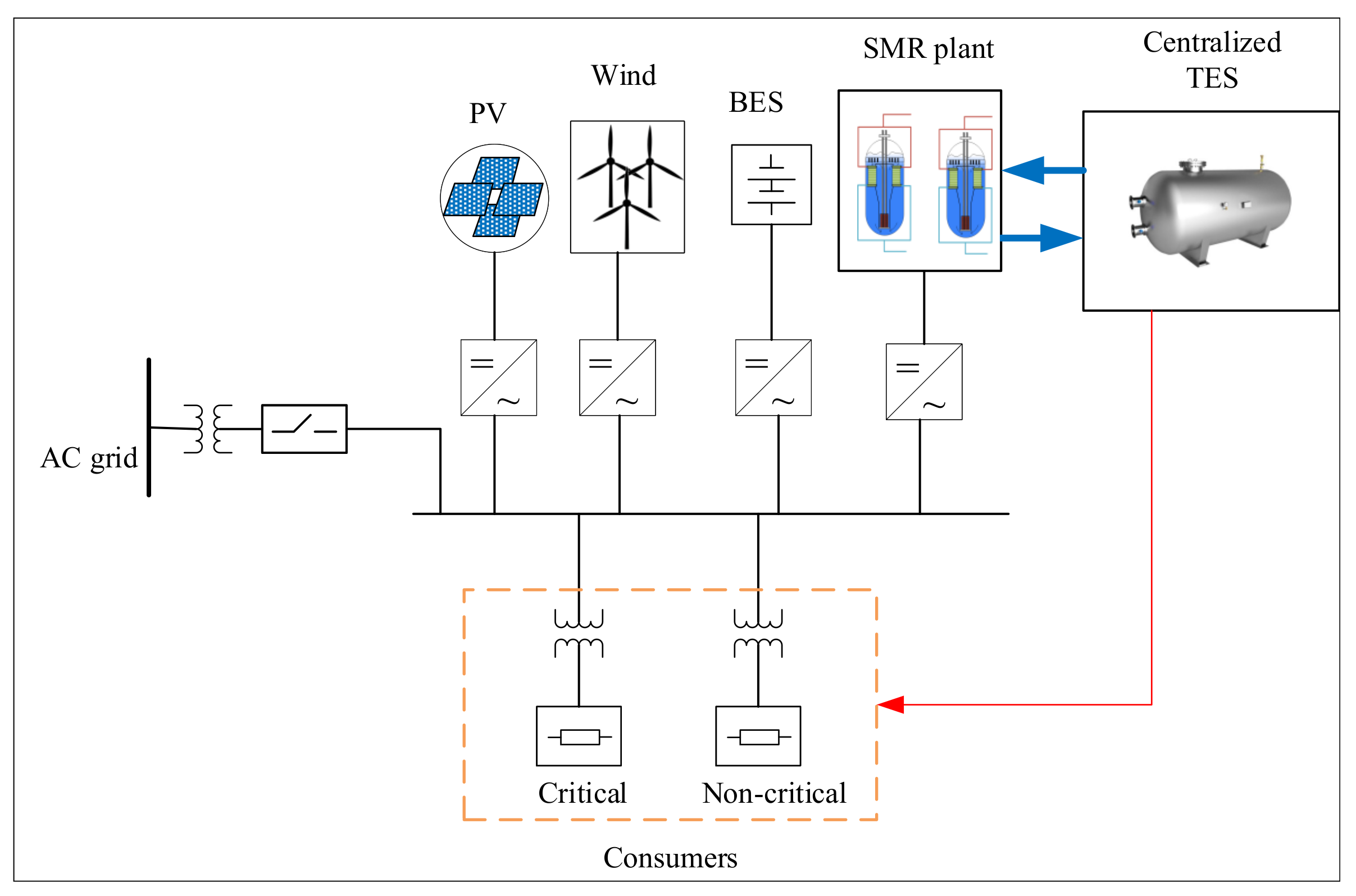





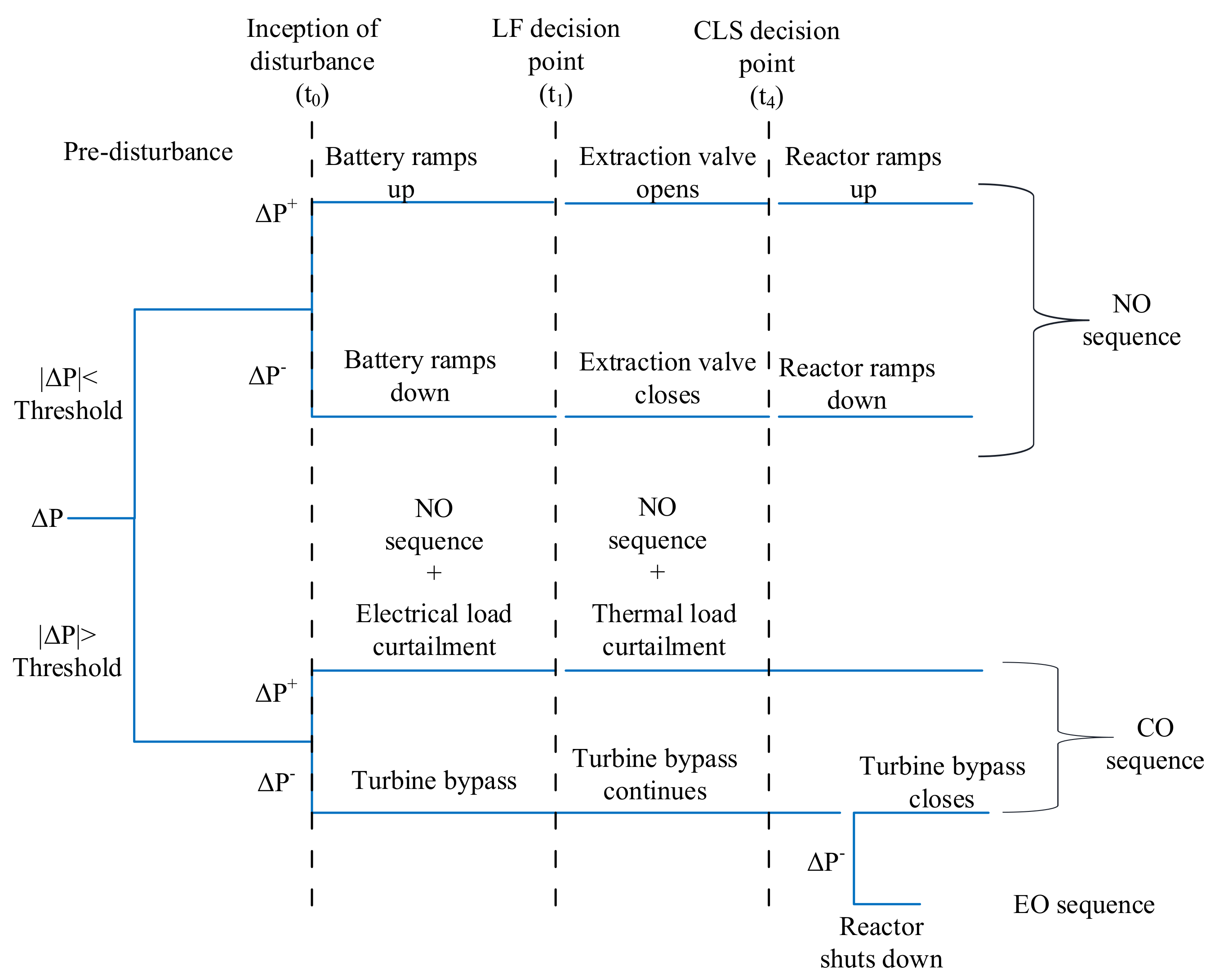


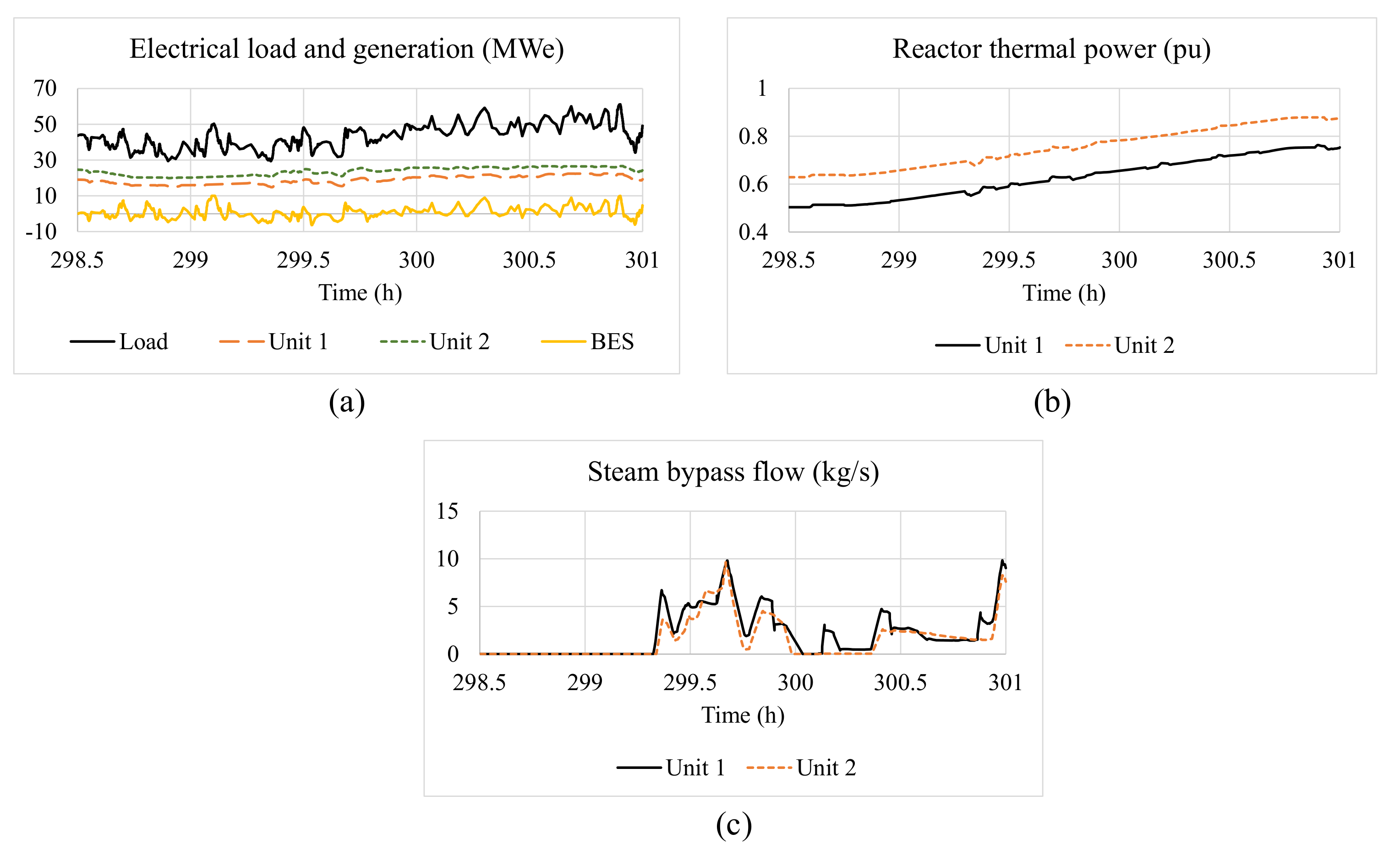
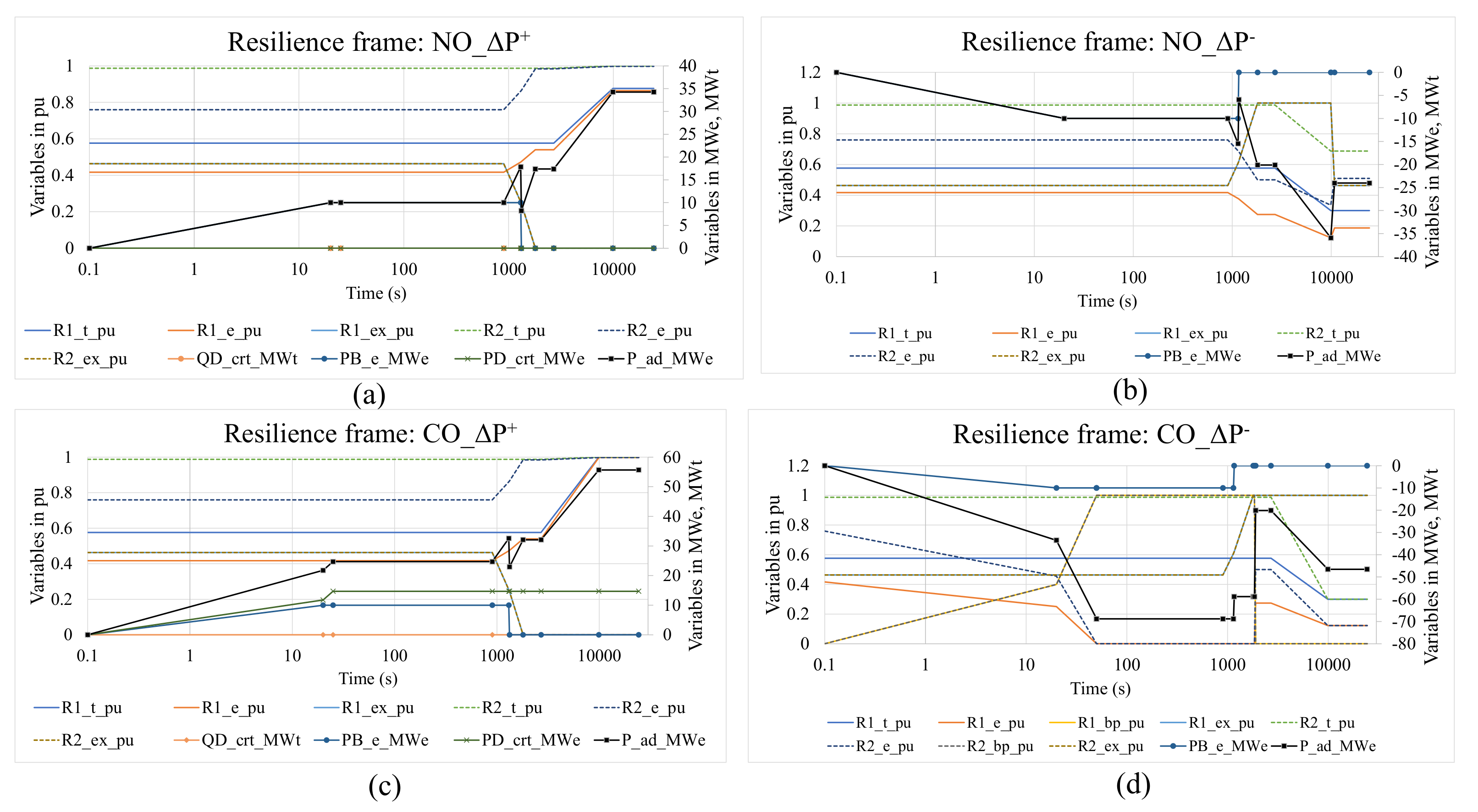
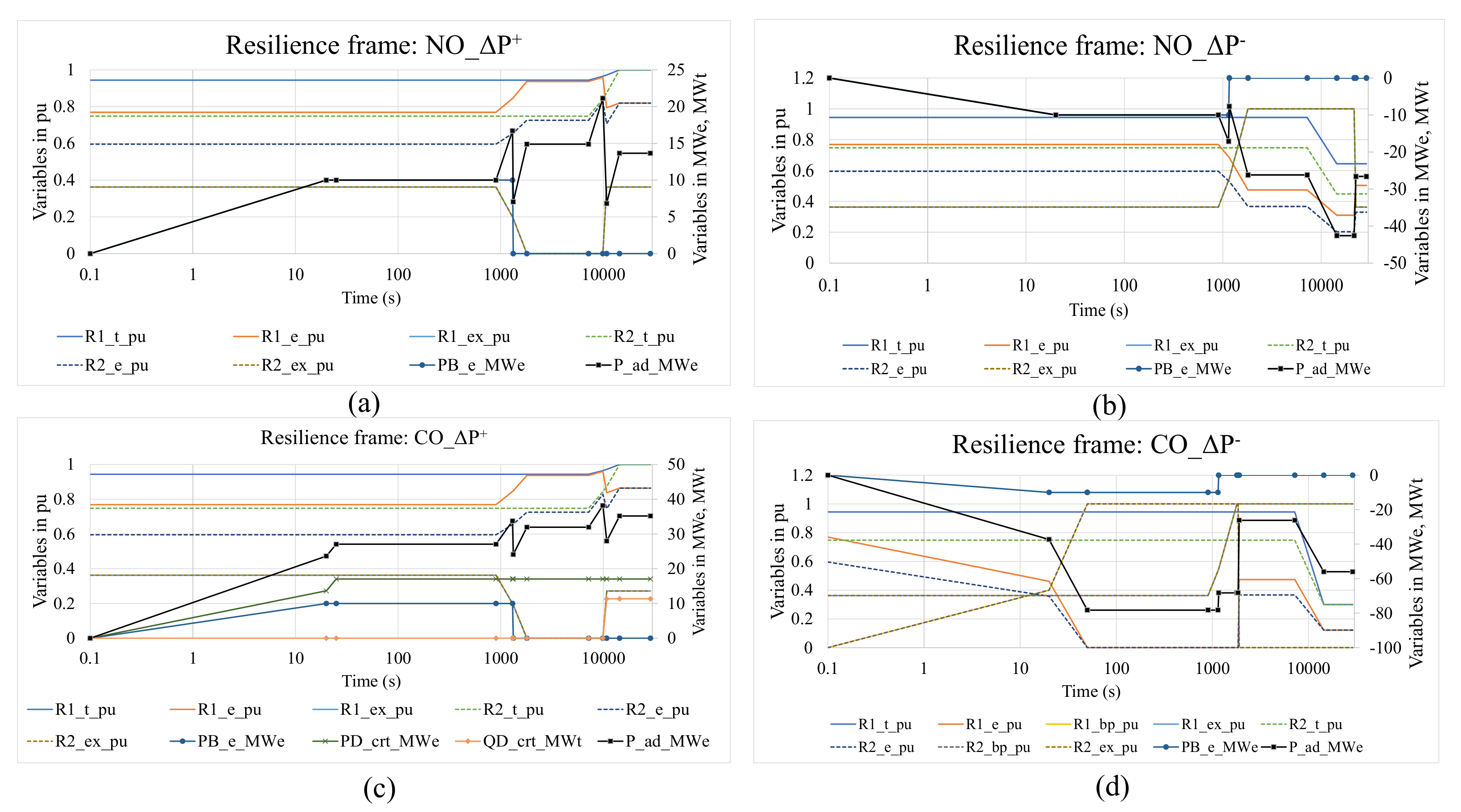
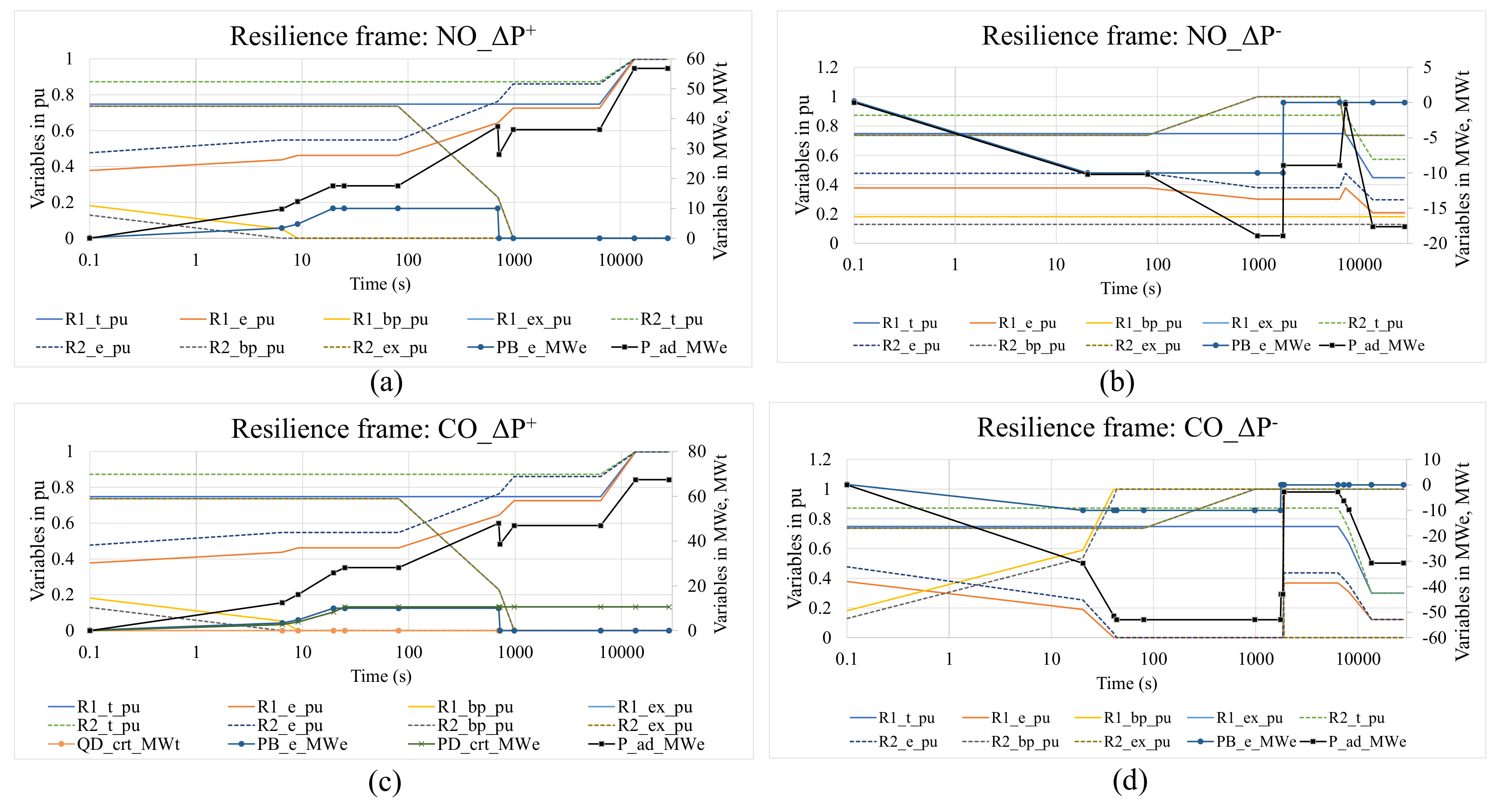


| Microgrid Assets | Parameters | |
|---|---|---|
| System Level | = 6 h, = 15 min, | |
| = 0.25 of , = 0.25 of | ||
| SMR Plant | Reactor | =2, = 2 h, = 4 h, = 50 MWe, |
| = 7.82 MWe, = 160 MWt, | ||
| = 32 MWt, = 65.93 kg/s, = 0.3 pu, | ||
| = −0.15 pu/h, = 0.15 pu/h | ||
| Steam Extraction | = 128 C | |
| Turbine Bypass | = 0.1 Hz, = 2* = 30 min, | |
| = −1.32 kg/s2, = 1.32 kg/s2 | ||
| DH system | = = 50 kg/s; = 20,000 m3; | |
| = 70 C; = 98 C; = 4.18 kJ/kg C; | ||
| = 90 C; = 70 C | ||
| BES | = 10 MWe, = −10 MWe, = 10 MWeh, | |
| = 0.95 pu, = 0.25 pu | ||
| = −0.5 MW/s, = 0.5 MW/s | ||
| Wind | = 20; = 1.5 MWe; = 14.4 km/h; | |
| = 37 km/h; = 90 km/h | ||
| PV | =16%; = 109,649.1 m2 |
| Variable | Description |
|---|---|
| Rx_t_pu, x = 1,2 | Reactor thermal power level of unit x in pu |
| Rx_e_pu, x = 1,2 | Reactor electrical power level of unit x in pu |
| Rx_ex_pu, x = 1,2 | Extraction steam flow rate of unit x in pu |
| Rx_bp_pu, x = 1,2 | Bypass steam flow rate of unit x in pu |
| PB_e_MWe | Battery electrical power output in MWe |
| PD_crt_MWe | Electrical load curtailed in MWe |
| QD_crt_MWt | Thermal load curtailed in MWt |
| P_ad_MWe | Microgrid adaptive real-power capacity in MWe |
Publisher’s Note: MDPI stays neutral with regard to jurisdictional claims in published maps and institutional affiliations. |
© 2022 by the authors. Licensee MDPI, Basel, Switzerland. This article is an open access article distributed under the terms and conditions of the Creative Commons Attribution (CC BY) license (https://creativecommons.org/licenses/by/4.0/).
Share and Cite
Poudel, B.; Lin, L.; Phillips, T.; Eggers, S.; Agarwal, V.; McJunkin, T. Operational Resilience of Nuclear-Renewable Integrated-Energy Microgrids. Energies 2022, 15, 789. https://doi.org/10.3390/en15030789
Poudel B, Lin L, Phillips T, Eggers S, Agarwal V, McJunkin T. Operational Resilience of Nuclear-Renewable Integrated-Energy Microgrids. Energies. 2022; 15(3):789. https://doi.org/10.3390/en15030789
Chicago/Turabian StylePoudel, Bikash, Linyu Lin, Tyler Phillips, Shannon Eggers, Vivek Agarwal, and Timothy McJunkin. 2022. "Operational Resilience of Nuclear-Renewable Integrated-Energy Microgrids" Energies 15, no. 3: 789. https://doi.org/10.3390/en15030789







